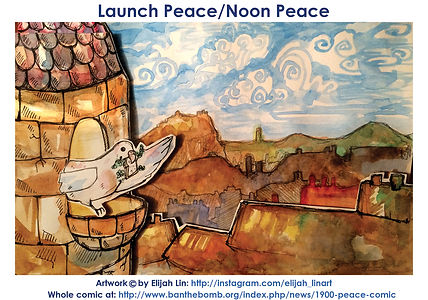

dove tales freedom of expression

peace piece
At Dove Tales we love all the arts, so we're delighted to present this charming graphic comic on the theme of peace.
The artwork is by Elijah Lin and both it and the words (by Anonymous) play on Scots words connected with doves and peace.
It was first published by our colleagues at Scottish CND.
Elijah is an Edinburgh illustrator. He was born and raised here but every few years, he takes a trip to Hong Kong to get back to the roots of his heritage. His art is inspired mainly from Japanese manga though is branching out into more experimental and alternative fields. His illustrations have been published in Scottish sci-fi magazine, Shoreline of Infinity.








PEACE PIECE
Artwork copyrighted by Elijah Lin https://instagram.com/elijah_linart
Words by Anonymous
This comic aims to:
• Symbolise peace being made and kept by ordinary people in Scotland
• Promote peace in an accessible format
• Inform people about survivors of the atomic bombings in Japan in 1945
• Signpost people to further sources of information about these survivors
This comic uses puns, homonyms, and Scots words, all explained here:
Title ‘Peace’ = freedom from war. ‘Piece’ = a work of illustration and writing (i.e. this comic). So ‘Peace Piece’ is a comic about peace.
‘Piece’ is also the Scots word for ‘sandwich’ and it has that meaning throughout the comic.
Frame 1 ‘Spread peace’ = promote peace. Everyone can promote peace in their daily life.
‘Spread a piece’ = spread a sandwich. The Scots word ‘piece’ means a piece of food or snack,
now usually a piece of bread, scone etc. with butter, jam etc.
Frame 2 ‘Do’ = to perform or accomplish, as in the expression ‘let’s do lunch’ (= let’s have lunch together).
So ‘do peace’ means ‘achieve peace’ or ‘practise peace’.
‘Doo’ is the Scots word for ‘dove’. A dove carrying an olive branch is a symbol of peace. In this comic, watercress represents an olive branch and is used in the sandwiches (along with hummus).
Frame 3 ‘Launch peace’ = a pun on ‘lunch piece’, in other words a sandwich you would eat for your lunch.
‘Launch’ = send forth, initiate (e.g. a boat or book)
‘Noon piece’ = Scots for a lunchtime snack of sandwiches etc.
Frame 4 ‘Reign’ and ‘Rain’
Frame 5 ‘Coo’ = a sound that doves make. The 3rd syllable of ‘Hibakusha’. See note 1 below for the meaning of ‘Hibakusha’.
Frame 5 shows the Japanese manga (= Japanese comic) artist Keiji Nakazawa. Inthe first half of the frame, he is a young boy drawing manga. In the second half ofthe frame he is an older man, at his drawing desk. ‘Hibakusha’ (pronounced ‘hibah-ckoo-shah’) is the Japanese word given to people who survived the 1945 atomicbombings of Hiroshima and Nagasaki.Keiji Nakazawa was from Hiroshima. He recorded his experiences as a hibakusha insome manga (comics) called ‘Barefoot Gen’. Later, he made the manga into ananimated film. For further information about Barefoot Gen, see https://en.wikipedia.org/wiki/Barefoot_Gen
Frame 8 ‘Peace maker’ = someone who makes or produces peace
‘Piece maker’ = someone who makes sandwiches
1) Chambers Concise Dictionary. Chambers Harrap, Edinburgh, 1997.
2) Concise Scots Dictionary, the Scottish National Dictionary Association Ltd., 1985. Polygon, Edinburgh.
This peace comic can also be seen on Scottish CND's page:
http://www.banthebomb.org/images/stories/pdfs/peace_piece.pdf
